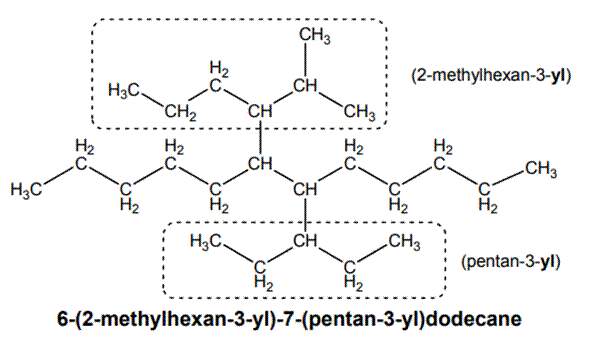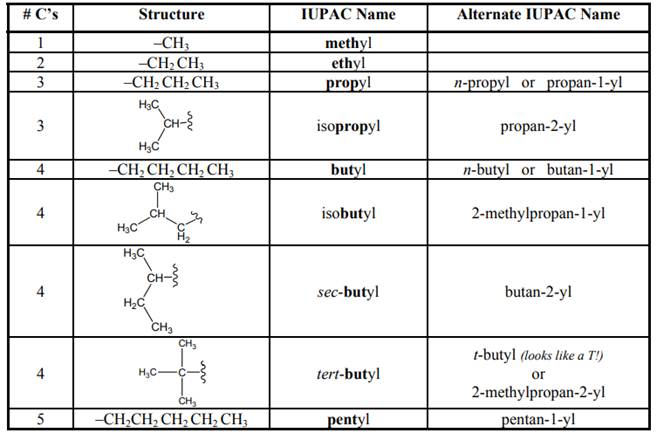
Organic Chemistry: A Guided Inquiry
2nd Edition
ISBN: 9780618974122
Author: Andrei Straumanis
Publisher: Cengage Learning
expand_more
expand_more
format_list_bulleted
Concept explainers
Question
Chapter NW1, Problem 23CTQ
Interpretation Introduction
Interpretation: Information conveyed by the number preceding each “yl” in the below structure should be explained.

Concept introduction: Any substituent that protrudes from certain carbon of parent chain is termed side chain. In hydrocarbon with branches the chief side chains are illustrated below:

Expert Solution & Answer
Want to see the full answer?
Check out a sample textbook solution
Students have asked these similar questions
Please answer all of it. If not, please skip.
Draw the structure of a branched hydrocarbon that also contains at least one atom with
trigonal planar geometry.
Draw the structure of an aromatic hydrocarbon containing two halogens.
Draw the structure of a molecule containing an aliphatic primary amine and a carboxyl group.
Draw the structure of an acyclic molecule containing a primary and a secondary alcohol group.
Draw the structure of an achiral tertiary alcohol
2. Consider the following organic molecules A-H. Many of them are natural products isolated
from Nature. Please answer the following questions by writing the Letter pertaining to
each molecule next to the question.
-N-
H;C
"CO,H
N.
Но
CH2
ČH3
B strychnine
(a plant alkaloid)
hirsutic acid
A nepetalactone
(essence of cutnip)
(a fimgul metabolito)
H-
H.
I CH,0
E helminthosporal
(a imgal toxu)
D
progesterone
F
cantharidin
(a progestin hommone)
(am insect vesicant)
Br
NO2
Br
CI
G untenine C
(E)-1,6-dibromo-2,7-dichloro-3,7-dimethyloct-3-ene
(fom red algae)
(4 sponge metabolite)
1. When 2-chloropropane treated with NaOH and 1-chloropropane treated with NaOH separately produce two different functional groups. Provide both reactions and explain the two different functional groups produced.
2. Circle and name at least three functional groups in the molecule below. Place an asterisk (*) beside any chiral carbons
Chapter NW1 Solutions
Organic Chemistry: A Guided Inquiry
Ch. NW1 - Prob. 1CTQCh. NW1 - (E) Write a correct name below each of the...Ch. NW1 - (E) What suffix do all the names in Model 1 have...Ch. NW1 - (E) What prefix stands for eight carbons?Ch. NW1 - Prob. 5CTQCh. NW1 - Prob. 6CTQCh. NW1 - Prob. 7CTQCh. NW1 - Prob. 8CTQCh. NW1 - Prob. 9CTQCh. NW1 - Use Model 1 to propose names for three-, four-,...
Ch. NW1 - Prob. 11CTQCh. NW1 - Prob. 12CTQCh. NW1 - Prob. 13CTQCh. NW1 - Name the following alkanes.Ch. NW1 - (Check your work.) Explain what is wrong with each...Ch. NW1 - Prob. 16CTQCh. NW1 - Draw the following alkanes a....Ch. NW1 - Prob. 18CTQCh. NW1 - Draw structures that correspond to the following...Ch. NW1 - For mono-substituted cycloalkanes the “1” is not...Ch. NW1 - Prob. 21CTQCh. NW1 - Prob. 22CTQCh. NW1 - Prob. 23CTQCh. NW1 - Prob. 24CTQCh. NW1 - Prob. 25CTQCh. NW1 - Write the name of the molecule on the left using...Ch. NW1 - Prob. 1ECh. NW1 - Prob. 2ECh. NW1 - Name each of the following structures.
Knowledge Booster
Learn more about
Need a deep-dive on the concept behind this application? Look no further. Learn more about this topic, chemistry and related others by exploring similar questions and additional content below.Similar questions
- (E) Write a correct name below each of the unbranched alkanes in CTQ 1.arrow_forwardWith reference to structure A, label structure B as an identical compound, a constitutional isomer, a resonance structure, or none of the above. Select the single best answer.arrow_forwardQuestion 3 Indicate the differences between structures A and B. (You can use PubChem to get a clearer structure of cocaine.) Question 4 Cocaine A Which of the following are incorrect? A B موجه C B 8 لاسة NH 8—8 Brarrow_forward
- For the cation shown, four resonance structures are possible. Two resonance forms are given, but they are incomplete. Complete structures 1 and 2 by adding nonbonding electrons and formal charges. Complete the two remaining resonance structures according to their description, including nonbonding electrons and formal charges. Structure 1: add lone pairs and charges X H₂C H₂C CH3 CH₂ Structure 2: add lone pairs and charges H₂C H₂C 0- CH₂ CH₂arrow_forwardGive the missing structure in each box.arrow_forwardHi ! Can you please explain how this organic molecule would have a Z configuration? Thanksarrow_forward
- 1. Simple sugars are defined as polyhydroxy aldehydes/ketones. All carbons except one have an OH group. The remaining carbon has a double bond to oxygen, making it an aldehyde or ketone. For example, the Fisher projection of glucose looks like this: C H- H- -ОН НО -ОН -HO- CH2OH Because a simple sugar has both a carbonyl carbon and built-in nucleophiles, a reaction can occur within the molecule itself to create the hemi-acetal form of the sugar. Propose a mechanism for this reaction when it occurs in an aqueous solution. C -- CH2OH он в CH2OH HO- H H НО H. ОН Н and ОН Н HO- он Он а OH H H- ОН OH H ОН ČH2OHarrow_forward2. The molecules shown below are four terpineol isomers. They are isolated from plants and have distinct aromas. For example, a -terpineol is a common perfume ingredient and smells similar to lilacs. Hol H-O- a-terpineol B-terpineol Y-terpineol 4-terpineol A) Draw a structural isomer of terpineol that meet the following criteria. You should draw one unique structure for each set. You must draw each molecule twice, once as a skeletal structure and once as a complete Lewis structure showing all atoms, bonds, and lone pairs of electrons. i. Does not have a ring. ii. Has an E alkene. iii. Has a secondary alcohol. iv. Does not contain an alcohol. B) Draw a complete Lewis structure of a-terpineol showing all bonds, atoms and lone pairs of electrons.arrow_forwardDraw structures in blank boxes to complete the following reactions. mb O₂N by HNLICH H₂N CI flou OH OH y H₂O HO 1. LIAIH 2. H₂O* XS NH3, 1. NaOH, H₂O, A 2. H₂O*arrow_forward
- Find the structures of the A-B-C compounds formed in the following reactions.arrow_forwardWhat is relationship between the two structures shown below? CI H CH3 H-NH2 CI- -H- H NH2 ČH;CH3arrow_forwardCircle and label all functional groups in neurolenin D. Label any alcohols as primary, secondary, or tertiary. (See picture attached)arrow_forward
arrow_back_ios
SEE MORE QUESTIONS
arrow_forward_ios
Recommended textbooks for you
 Organic Chemistry: A Guided InquiryChemistryISBN:9780618974122Author:Andrei StraumanisPublisher:Cengage Learning
Organic Chemistry: A Guided InquiryChemistryISBN:9780618974122Author:Andrei StraumanisPublisher:Cengage Learning

Organic Chemistry: A Guided Inquiry
Chemistry
ISBN:9780618974122
Author:Andrei Straumanis
Publisher:Cengage Learning